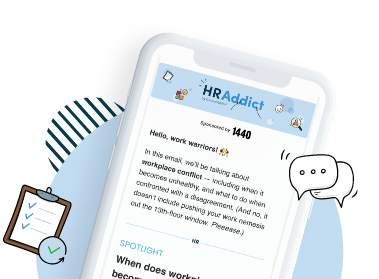Lazy employees are probably the worst type out of the bunch of difficult coworkers. They don’t pull their weight; they distract other employees, and they do anything other than work on company time. Yet every workplace seems to have at least one slacker in the team, and it’s your responsibility as the boss to manage the situation.
So, how do you deal with Jane from Accounting, who spends six hours a day surfing social media sites, and Trevor from Marketing, who sneaks into the office after taking a two-hour lunch on a daily basis?
Here are 15 strategies to follow that will help stimulate productivity and make lazy employees snap out of their bad habits!
1. Have a private chat
The first step to take when tackling an unprofessional employee is to simply call them out on their poor behavior. It’s imperative to do this in private; you don’t want to dishearten them even more by belittling them in front of their colleagues.
Secondly, it’s important to remain polite. Even if you’re frustrated, you definitely shouldn’t show this or let it come out as anger throughout the discussion.
During the formal meeting, give constructive feedback about what is going on, while reminding the employee how important their role is to the business and how you know that they can perform well at all times.
2. Set clear goals
It’s most likely that your lazy employee needs to be reminded of what is expected of them. If they’ve been working in the same role for a while, they can quickly lose motivation and self-discipline and form their own set of rules to abide by.
This is where you come in — set them on the right path again! Set a clear direction that your lazy employee should be working towards, and be sure that they agree on these targets, too. For example, your employee may have a target of making 15 sales during the day but is only achieving 5. You could set an average goal of 10 for the first week and build on it as the employee improves, without putting too much pressure on their shoulders.
3. Offer regular department updates
By keeping employees updated on company goals, targets and achievements, they are more likely to be inspired and work harder as they can see tangible results. So, one way to crack down on lazy employees is to give regular department updates to keep them engaged and motivated. Instead of pointing fingers, you could also reference general areas of improvement within team meetings and encourage all employees to take note.
4. Review their responsibilities
A good way to deal with a lazy employee is to review their responsibilities. You may find that their work isn’t challenging enough. So, before you have a chat with them, compare their work with other team members and advise on any tasks that they can take on that challenge them. Alternatively, if they have too much on their plate and don’t know where to start, consider delegating to other team members.
5. Track their time
If an employee isn’t pulling their weight, consider tracking their time so you have proof of what they are and aren’t doing. While this method is frowned upon by a lot of professionals, it’s a good way to have valid data to bring up during a warning meeting — especially if you are proceeding down the route of firing the employee.
6. Offer more training
To show that you really do care about their personal and professional development, you could offer additional training where needed. This could either be to refresh their knowledge or to expand on their current skills and learn new processes.
By offering training, you are showing that you are committed to their development, which, in turn, should create a positive effect, forcing the employee to feel more motivated to progress and do well within the organization.
7. Create consequences
Once you have given your lazy employee all the tools they need to progress, such as training, extra attention, etc., you must set some consequences in place, in case they do not deliver.
For example, if an employee is making careless mistakes and not completing projects on time, you can advise them that you will need to give them a formal warning if they do not improve within a set period (usually one month). Afterwards, you can set additional consequences if they still do not improve.
8. Create incentives
While consequences may be a good tactic, incentives, on the other hand, can be just as powerful. If an employee is given an aim to work towards for something in return, they are more likely to work 10 times harder to ensure that they get there. After all, they’ll want to be rewarded!
If you choose this strategy, you need to ensure that it’s something worth fighting for, like a bonus, extra days off or even a paid weekend getaway.
9. Give them additional responsibilities
Occasionally, an employee will appear lazy because they are merely bored within their job role and aren’t given any tasks that motivate them anymore. A bored employee will never progress or make an effort. By giving them additional responsibilities to keep them entertained, you should see an increase in their productivity. This doesn’t necessarily mean that you need to increase their salary immediately or change their job title, though.
At this stage, the employee will feel valued within the company and motivated to show that they can do more and feel important.
10. Create opportunities for advancement
If a worker feels like there is no room for advancement, they will most likely stagnate within their role and become sloppy with their work, clocking in and out on a daily basis purely to receive a paycheck at the end of the month.
If you see that this is happening with employees that were once key players, you should consider creating opportunities for advancement, showing that there is a possibility for them to grow within the company.
11. Get to know their interests
Getting to know what your difficult employees are interested in can help you play to their strengths. They most likely will enjoy some aspect of their job, which means that you should give them duties that relate to their interests.
Let’s say an employee is an Excel whizz and likes working with numbers. You can give them an additional project that involves compiling statistics. Just be sure that these tasks don’t take too much time away from their regular duties — you don’t want them to slack even more in that department!
12. Don’t make it personal
When dealing with such sensitive matters, it’s important to keep the conversation professional and not personal. Ensure that you only give constructive criticism without it coming off as a personal attack. Your employee will naturally feel upset, and may take your suggestions to heart, so regardless of how they act, keep your composure and continue to offer professional advice throughout the meeting.
13. Document poor behavior
While trying the above methods, it’s important to document their behavior throughout. This is vital for two reasons, the first being that you need to have written proof of poor performance and the steps you took to help the worker, if you decide to dismiss them. And, secondly, because you will want to see if there has been any improvement over time.
This should also include any minutes from meetings you have had or times where you have needed to correct an employee’s mistakes.
14. Offer chances to make improvements
When you’re dealing with a lazy employee, you need to first point their faults to them, offer advice and support to help them improve, along with a handful of chances. Let’s say you’ve offered a first warning; you then need to provide training and an adequate amount of time for them to make your suggested improvements. If they still haven’t improved at all, then you will have no other option but to consider a final warning.
15. Know when it’s time to throw in the towel
There’s only so much you can do to motivate poorly performing employees, and sometimes you can’t help a lazy employee.
If you’ve honestly done all you can to help a bad worker, it might be time to throw in the towel and dismiss them. When doing so, be sure to consult your HR department and ensure that you are following the correct protocols. You don’t want a lawsuit flying your way after a bad dismissal!
Be sure to let other team members know the reason for the dismissal, so they don’t feel like they may be in the firing line, too.
Final thoughts
Handling a lazy employee is tough. You must ensure that you handle sensitive situations with care and follow the correct procedures along with your HR department. However, as a manager, it’s part of your job. So, to help you stay on the right track, follow the strategies listed above.
Join the discussion! Have you ever dealt with a lazy employee before? If so, join the conversation below and let us know.
This is an updated version of an article originally published back in 2018.

